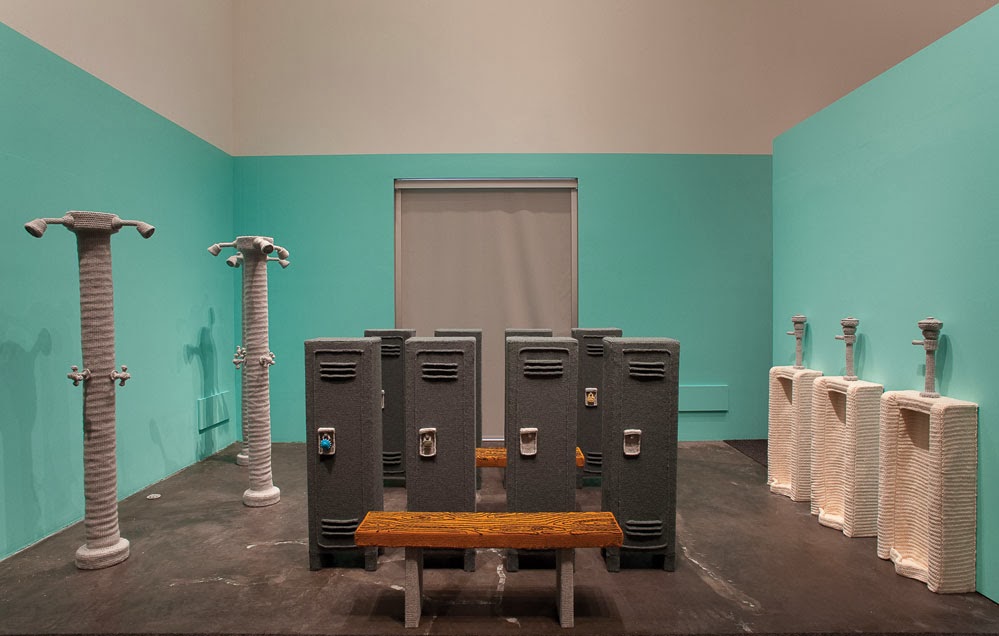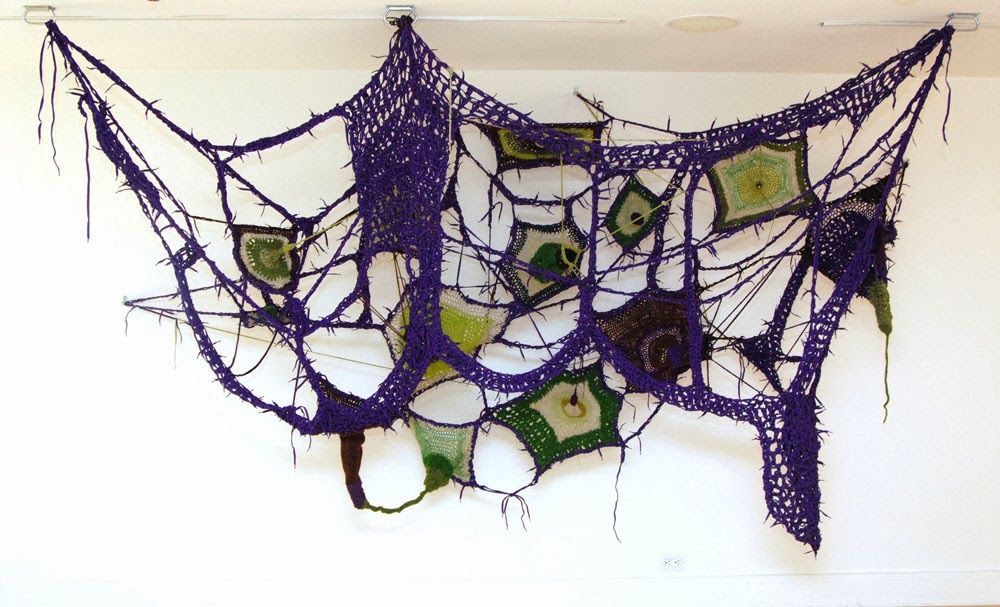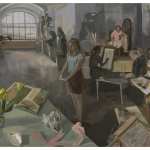�Let the threads be articulate.� � Anni Albers
Guest Contributor Clarity Haynes / The wall text at the portal to the exhibition “Queer Threads,” currently at the Leslie-Lohman Museum in Manhattan, bluntly states, �Is this work �gay?� You bet.� The show, with its confluence of queer and feminist sensibilities, is the perfect subversive, fuzzy, neon, rainbow, glittery storm. Transgression has never felt so friendly.
[Image at top: Larry Krone, Then and Now (Rainbow Order); 2008; yarn, wood, and hanging hardware; 44 x 39 inches. Courtesy of the Artist and Pierogi Gallery, New York]
Queer people have always existed in realms between and outside of codified gender norms, behaviors and culture, and as such have a special relationship to feminism. This exhibition, like much of contemporary art, walks a path paved by the feminist art movement of the 1970�s, which introduced the use of fabric and other materials historically associated with women�s crafts to the realm of fine art.
Curator John Chaich organized the show in sections addressing themes of pride, sexuality, and public/private space, and the show occupies the museum�s segmented yet open floor plan elegantly. In keeping with a philosophy of queerness, each area visually exceeds its boundaries. Artworks are perceived simultaneously; they overlap their borders; they seep from wall to floor, from one partitioned area into another. Fabric is soft and malleable and could function as a way to keep warm at night. It is, in some ways, like water, snaking around the place.
Entering the gallery, one is greeted by a pink-painted wall on the left, and straight ahead, a white wall with rainbow-colored fabric draped around it — front, back and side � which cascades into a luxuriant mound on the floor (Accumulated Pride, by Liz Collins). A neon-yellow, telescopic, macram� mobile by Jesse Harrod hangs from the ceiling, and just beyond it, one glimpses a glittering, king-sized quilt by L.J. Roberts. This rich piece, lent by the Smithsonian American Art Museum, is a heavy fabric mosaic blossoming with text, gold lam� and pink fabric triangles. It spills from the wall onto the floor in a multicolored, irreverent train of goofy, tubular tendrils.
144 x 228 inches (variable). Courtesy of the artist
In the back of the museum, one section hosts a life-sized, entirely crocheted locker room by Nathan Vincent. The lockers are cute, with their yarn combination locks, but the soft urinals that line one wall evoke Duchamp and Gober with a kind of snug, art-historical hug of brotherhood. The piece reminds us that queer sensibilities and content have existed as subtexts throughout art history.
Sheila Pepe�s larger-than-life, crocheted Your Granny�s Not Square (pictured above) is the strangest and most complex piece in the show. It is unapologetically purple (a color long beloved in lesbian feminist culture). It feels wedded to the work of sculptors Louise Bourgeois, Eva Hesse, and Nikki de Saint Phalle; yet it belongs very much in the 21st century. The looping, dangling web, humorously trailing shoelaces, is decidedly genderqueer in its feminism � phallic protuberances poke and sag, just as indentations and mandala-like sections radiate. It is replete with twists and turns, contradictions and complexities; in its spatial unpredictability and inventiveness it embodies queerness in the most tangible sense of the word.
Portraiture plays an emotive role here, through picturing and honoring LGBT relationships. An embroidered, beaded portrait of a male couple with their dachshund in a tropical setting, by Argentinian artists Chiachio & Giannone, enchants. Two Ladies, by Rebecca Levi, presents two embroidered female figures side by side, their arms raised above their heads, their breasts lovingly realistic in their shape and honesty. The oldest work in the show is a 1955 needlepoint of two reclining nude men by Allen Porter. It looks like a double portrait, not just a figure study; one of the men is reading a book, his leg crossed unselfconsciously. This piece foreshadows the work of contemporary artist Patricia Cronin, who has utilized neoclassical forms to pay homage to her relationship with her wife, artist Deborah Kass. The use of the traditionally feminine medium of needlepoint by a male artist at that time in history demonstrates the way in which queerness often complicates gender roles, and queer lives have existed outside of prescribed norms. This quiet, poignant piece is one of the most potent in the exhibition.
Another salient characteristic of this show is the ubiquity of text as strategy. There is the bright blue towel embroidered with the red yarn words Cum On Everybody by Sonny Schneider; the needlepoint Fuck Positive Women by Allyson Mitchell and Jessica Whitebread; the L.J. Roberts quilt stitched with the words �the queer houses of brooklyn�; the fabric magazine cover sporting titles like Locker Jock by Aaron McIntosh; and the old-fashioned, flowery quilt embroidered with phrases like �old maid,� �femme,� �dyke� and other queer identity markers, by Melanie Braverman. The most eye-catching text-based work is Allyson Mitchell�s purple-hued, striped knit panel. The size and shape of a political rally sign, it was used in a 2011 Toronto Pride march to protest the organization�s censorship of the group Queers Against Israeli Apartheid. The incisive critique Un-Queer Nation is woven across the panel in black capital letters, reminding us that the seeming unity of the LGBT community can often be deceptive.
The preponderance of text in the exhibition speaks to the history of text in needlepoint and embroidery, such as the samplers made by women in early American history. But it also illuminates the importance of text in the history of LGBT activism. Words hold extra weight in marginalized cultures, and they play an especially transformative role in the liberation of a people whose particular oppression has taken the form of hiding and silence.
Queer Threads involves the work of artists from all over the world, and curator John Chaich has spent two years putting it together. It packs a powerful punch, containing the complexities of love, humor, resilience, irreverent beauty, anger, sex, history and grief. Formally, it is homey and sweet � like a big, bright, soft hug. But it is the force of the content that makes this exhibition transcendent.
“Queer Threads: Crafting Identity and Community,” curated by John Chaich.� Leslie-Lohman Museum, Soho, New York, NY. Through March 16, 2014.
Related posts:
GoBrooklynArt: Haynes, Bond, and Arenas (2012)
Pepe brings old-school lesbian feminist imagery to Las Vegas (2009)
——
Two Coats of Paint is licensed under a Creative Commons Attribution – Noncommercial-No Derivative Works 3.0 United States License. For permission to use content beyond the scope of this license, permission is required.




















What an incisive, insightful contribution. Brava. Haynes's point about the use of text as symbolic liberation from traditional closeting resonates with Robert Indiana's recent show at the Whitney, which showcased his penchant for using words against myriad forms of suppression and sublimation–including gay secrecy.